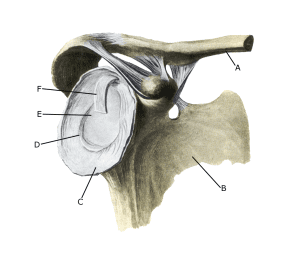Anatomy

Around the edge of the shoulder blade’s articular surface (cavitas glenoidalis) is a meniscus (labrum glenoidale). The meniscus is important for shoulder stability.
Shoulder blade articular surface, front view:
A. Clavicula
B. Scapula (shoulder blade)
C. Capsula articularis
D. Labrum glenoidale
E. Cavitas glenoidalis
F. M. biceps brachii (caput longum)
Cause
With repeated (over)loading or a single heavy load, the meniscus (labrum glenoidale) can tear or be torn from its attachment to the articular surface. After the meniscus is dislodged, it can become trapped in the joint.
Meniscus lesions are often combined with (partial) tears in the shoulder muscles or tearing of the biceps tendon attachment (SLAP lesion), as well as (partial) dislocation of the shoulder and can occur after a fall where the arm is outstretched or if the handball player is ‘caught in the arm’ at the moment of the shot. There are several different meniscus lesions.
Symptoms
Significant pain is experienced – typically deep in the joint – immediately following the injury. Pain in the shoulder joint during certain movements, typically when using the arm with resistance. There is usually normal mobility in the shoulder. You can often feel something ‘slipping’ in the joint.
Examination
Suspected meniscus lesions in the shoulder and lack of progress on rehabilitation should always lead to examination by a relevant professional (Apprehension test and Relocation test). An impression of the meniscus can be obtained by MRI with contrast in the joint (or 3TMR) and ultrasound, but the lesion is best assessed by arthroscopy (binocular examination of the shoulder), where treatment can take place in the same session.
Treatment
The vast majority are treated with rehabilitation, which brings about 75% back to the same level of sport (Steinmetz RG, et al. 2022) and often only after ½ year (Freijomil N, et al. 2020). If relief and rehabilitation are not successful, referral for arthroscopy is advised to determine the diagnosis and whether surgical treatment is possible.
Complications
If the progress is not smooth, you should consider whether the diagnosis is correct or if there are complications.
In particular, the following should be considered:
- Rupture of the upper shoulder blade muscle
- Inflammation of the tendon sheath of the upper shoulder blade muscle
- Rupture of the biceps tendon
- Luxation of the joint between the shoulder blade and the collarbone
- Frozen shoulder
- Muscle infiltrations
- Partial dislocation of the shoulder
- Nerve entrapment on the back of the shoulder blade
